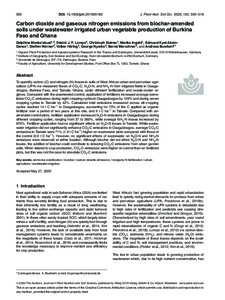| dc.contributor.advisor | | |
| dc.date.accessioned | 2020-08-17T09:10:47Z | |
| dc.date.available | 2020-08-17T09:10:47Z | |
| dc.date.issued | 2020-06-30 | |
| dc.identifier | doi:10.17170/kobra-202008121561 | |
| dc.identifier.uri | http://hdl.handle.net/123456789/11695 | |
| dc.description.sponsorship | Gefördert im Rahmen des Projekts DEAL | |
| dc.language.iso | eng | |
| dc.rights | Namensnennung 4.0 International | * |
| dc.rights.uri | http://creativecommons.org/licenses/by/4.0/ | * |
| dc.subject | ammonia volatilization | eng |
| dc.subject | biochar | eng |
| dc.subject | carbon dioxide emissions | eng |
| dc.subject | inorganic N fertilization | eng |
| dc.subject | urban agriculture | eng |
| dc.subject | waste irrigation | eng |
| dc.subject.ddc | 630 | |
| dc.title | Carbon dioxide and gaseous nitrogen emissions from biochar‐amended soils under wastewater irrigated urban vegetable production of Burkina Faso and Ghana | eng |
| dc.type | Aufsatz | |
| dcterms.abstract | To quantify carbon (C) and nitrogen (N) losses in soils of West African urban and peri‐urban agriculture (UPA) we measured fluxes of CO₂‐C, N₂O‐N, and NH₃‐N from irrigated fields in Ouagadougou, Burkina Faso, and Tamale, Ghana, under different fertilization and (waste‐)water regimes. Compared with the unamended control, application of fertilizers increased average cumulative CO₂‐C emissions during eight cropping cycles in Ouagadougou by 103% and during seven cropping cycles in Tamale by 42%. Calculated total emissions measured across all cropping cycles reached 14 t C ha⁻¹ in Ouagadougou, accounting for 73% of the C applied as organic fertilizer over a period of two years at this site, and 9 t C ha⁻¹ in Tamale. Compared with unamended control plots, fertilizer application increased N₂O‐N emissions in Ouagadougou during different cropping cycles, ranging from 37 to 360%, while average NH₃‐N losses increased by 670%. Fertilizer application had no significant effects on N₂O‐N losses in Tamale. While wastewater irrigation did not significantly enhance CO₂‐C emissions in Ouagadougou, average CO₂‐C emissions in Tamale were 71% (1.6 t C ha⁻¹) higher on wastewater plots compared with those of the control (0.9 t C ha⁻¹). However, no significant effects of wastewater on N₂O‐N and NH₃‐N emissions were observed at either location. Although biochar did not affect N₂O‐N and NH₃‐N losses, the addition of biochar could contribute to reducing CO₂‐C emissions from urban garden soils. When related to crop production, CO₂‐C emissions were higher on control than on fertilized plots, but this was not the case for absolute CO₂‐C emissions. | eng |
| dcterms.accessRights | open access | |
| dcterms.creator | Manka'abusi, Delphine | |
| dcterms.creator | Lompo, Désiré Jean-Pascal | |
| dcterms.creator | Steiner, Christoph | |
| dcterms.creator | Ingold, Mariko | |
| dcterms.creator | Akoto-Danso, Edmund Kyei | |
| dcterms.creator | Werner, Steffen | |
| dcterms.creator | Häring, Volker | |
| dcterms.creator | Nyarko, George | |
| dcterms.creator | Marschner, Bernd | |
| dcterms.creator | Buerkert, Andreas | |
| dc.relation.doi | doi:10.1002/jpln.201900183 | |
| dc.subject.swd | Abwasser | ger |
| dc.subject.swd | Bewässerungswirtschaft | ger |
| dc.subject.swd | Bewässerung | ger |
| dc.subject.swd | Gemüsebau | ger |
| dc.subject.swd | Kohlendioxid | ger |
| dc.subject.swd | Abgas | ger |
| dc.subject.swd | Burkina Faso | ger |
| dc.subject.swd | Ghana | ger |
| dc.type.version | publishedVersion | |
| dcterms.source.identifier | EISSN 1522-2624 | |
| dcterms.source.issue | Issue 4 | |
| dcterms.source.journal | Journal of Plant Nutrition and Soil Science (JPNSS) | eng |
| dcterms.source.pageinfo | 500-516 | |
| dcterms.source.volume | Volume 183 | |
| kup.iskup | false | |


